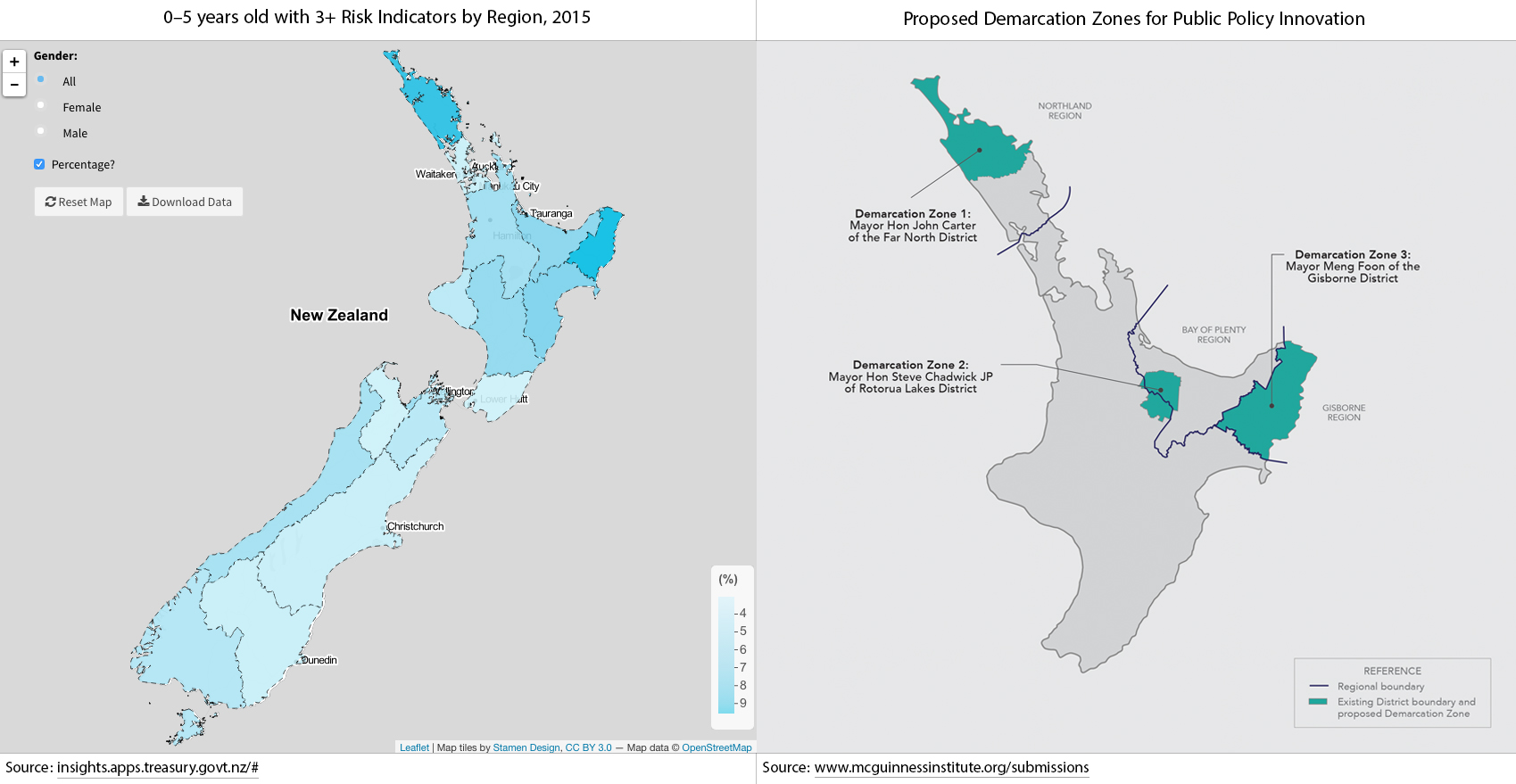The New Zealand Treasury (Kaitohutohu Kaupapa Rawa) has recently developed Insights, an interactive online tool that enables users to explore poverty in New Zealand. It is a new tool that supports our recommendation for governance lines within New Zealand to be simplified, with the creation of demarcation zones for public policy innovation as a way to fast-track this alignment (see Background to Project TacklingPovertyNZ below). Insights draws on information available from a range of public sector agencies to establish comprehensive data visualisations and maps of the very real and prevalent poverty that hinders opportunities for New Zealand’s children and youth (see image on the left below). The tool has been designed to inform policies and services through better information provision. We highly recommend it as a way for people to understand the effects of poverty in New Zealand on various groups and areas.
Insights has three areas of analysis:
1. Children and youth at risk,
2. Youth transitions to adulthood, and
3. Services for children and youth.
Insights enables users to explore comprehensive data on the prevalence of poverty as indicated by risk factors. Insights identifies ‘children at risk’ using four risk indicators:
- ‘Having a Child Youth & Family finding of abuse or neglect
- Being mostly supported by benefits since birth
- Having a parent with a prison or community sentence
- Having a mother with no formal qualifications’
‘Youth at risk are identified as being in one or more of ten target populations:
15 to 19 year olds
- Teenage boys with Youth Justice or Corrections history
- Teenagers with health, disability issues or special needs
- Teenage girls supported by benefits
- Mental health service users with stand-down or CYF history
- Experienced significant childhood disadvantage
20 to 24 year olds
- Young offenders with a custodial sentence
- Young offenders with a community sentence and CYF history
- Jobseekers in poor health with CYF history
- Sole parents not in fulltime employment with CYF history
- Long-term disability beneficiaries’.
The data visualisations and mapping tools present ‘information about risk, outcomes, and service use for children aged 0 to 14, and youth aged 15 to 24 in New Zealand’. The Insights tool is ‘part of Treasury’s commitment to higher living standards and a more prosperous, inclusive New Zealand’. Explore the Higher Living Standards Framework on the Treasury website.
Background to Project TacklingPovertyNZ
The McGuinness Institute’s ongoing Project TacklingPovertyNZ aims to contribute to a national conversation on how to reduce poverty in New Zealand. Our latest publication, Think Piece 26 – Doing Something About Poverty in New Zealand by Conal Smith, explores seven proposals to address poverty in New Zealand that are worthy of investigation. The second proposal in the think piece draws on the work we did at the end of 2016 in the Proposal to the Prime Minister on Demarcation Zones for Public Policy Innovation. The proposal was a response to the entrenched forms of poverty we found during the TacklingPovertyNZ 2016 workshop series and to the fact that while the tools for tackling poverty may be centralised, the knowledge for tackling poverty is local. The demarcation zones are instruments of public policy that aim to tackle poverty and build economic wealth in three zones through decentralisation. Decentralisation is a way of enabling local governance representatives and their communities to develop solutions designed for their specific needs and, where innovations are successful, provides opportunities for sharing solutions with other communities. The three zones, the Far North, Rotorua and Gisborne, were selected as three specific areas whose communities are significantly impacted by poverty, where there is an acceptance that the status quo is not working in each of them and where demand for change is a moral imperative. The high levels of deprivation in these areas are reflected by the data in the Insights tool (see image below – Insights data on the left and demarcation zones on the right).

On the left is an example of how data mapping is provided by Insights. Darker blue indicates a higher percentage of 0–5 year olds with three or more risk factors. On the right are the McGuinness Institute proposed demarcation zones.
To stay up to date with Project TacklingPovertyNZ, please subscribe to the newsletter here.
